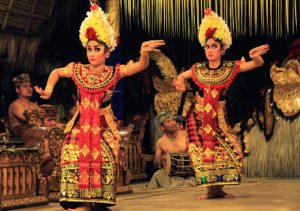Attending Gamelan Cudamani’s performance was an amazing experience that I would not have attended if it weren’t for our class. When I first saw the assignment that required us to attend Gamelan Cudamani, I did a brief google search to see what the performance would entail. I quickly realized that Gamelan was a traditional Balinese style of song and dance. Although intrigued, I was confused about what it had to do with our classroom discussions that, up to that point, had mainly focused on gender, feminism, and identity among other topics. I had a hypothesis that the performance would have to do with expression of identity in some way, but otherwise had very few expectations when I walked into the Modlin Center that night.
As soon as the performance began, I was hooked. I was fascinated by the multitude of layers that were all overlapping at once. The songs could almost be dissected into individual pieces – each instrument playing at a different pace and tone. Yet, the sound that they produced as a whole was cohesive and exciting to listen to. The musicians and dancers were constantly in rhythm, almost as if responding to one another. The level of preparation and practice that must go into each song is mind boggling. I particularly enjoyed the three songs that were played after intermission. The narrator referred to these songs essentially as the three traditional interpretations of water. The first piece was about water in its natural state. It was unpredictable and violent with bells being played at astonishing speeds to replicate the water’s rapid movement and flow. The second piece was about water in the fields and how it provides rice for farmers. During this song, dancers dressed as farmers moved to a much calmer rhythm. The dance portrayed a farmer’s work day, and how humor can be used as relief when exposed to harsh work conditions. The third song dealt with the divine aspect of water. The accompanying dance showed performers honoring the god of rice while one dancer dressed as her presided above them.
While I didn’t know it going in, this performance had much to do with several keywords and talking points that we have explored in class. Identity is probably the most obvious one. This music was an expression of heritage and traditional art that is part of the collective Balinese identity. Everything from the instruments, composition, and clothing of the performers reflected this identity in some way. The narrator explained that their music school and practices are held in a small Balinese village in order to stay true to tradition and make sure that the music they present is always culturally authentic. Gender and feminism were two keywords that were also touched on by the performance.
 It was explained to the audience that women were performing in traditionally male roles at several points during the show. Additionally, a woman composed one of the songs that was performed, challenging another male dominated position in Gamelan music. There was a male dancer in a couple songs that I noted wearing a dress. While I do not know traditional Balinese clothing norms, it was something that I could use a queer lens to think about differently.
It was explained to the audience that women were performing in traditionally male roles at several points during the show. Additionally, a woman composed one of the songs that was performed, challenging another male dominated position in Gamelan music. There was a male dancer in a couple songs that I noted wearing a dress. While I do not know traditional Balinese clothing norms, it was something that I could use a queer lens to think about differently.
Gamelan Cudamani is a perfect case study for media, culture, and identity. It exemplified the intersection of all three of these topics and took a progressive approach in performing traditional song and dance. I was glad I attended, and hope to see Gamelan again in the future.
Image: https://cap.ucla.edu/archive/events/demonstration_performance_%3Cbr%3Egamelan_cudamani%3Cbr%3E
